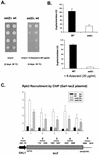Methylation of histone H3 by Set2 in Saccharomyces cerevisiae is linked to transcriptional elongation by RNA polymerase II
- PMID: 12773564
- PMCID: PMC427527
- DOI: 10.1128/MCB.23.12.4207-4218.2003
Methylation of histone H3 by Set2 in Saccharomyces cerevisiae is linked to transcriptional elongation by RNA polymerase II
Abstract
Set2 methylates Lys36 of histone H3. We show here that yeast Set2 copurifies with RNA polymerase II (RNAPII). Chromatin immunoprecipitation analyses demonstrated that Set2 and histone H3 Lys36 methylation are associated with the coding regions of several genes that were tested and correlate with active transcription. Both depend, as well, on the Paf1 elongation factor complex. The C terminus of Set2, which contains a WW domain, is also required for effective Lys36 methylation. Deletion of CTK1, encoding an RNAPII CTD kinase, prevents Lys36 methylation and Set2 recruitment, suggesting that methylation may be triggered by contact of the WW domain or C terminus of Set2 with Ser2-phosphorylated CTD. A set2 deletion results in slight sensitivity to 6-azauracil and much less beta-galactosidase produced by a reporter plasmid, resulting from a defect in transcription. In synthetic genetic array (SGA) analysis, synthetic growth defects were obtained when a set2 deletion was combined with deletions of all five components of the Paf1 complex, the chromodomain elongation factor Chd1, the putative elongation factor Soh1, the Bre1 or Lge1 components of the histone H2B ubiquitination complex, or the histone H2A variant Htz1. SET2 also interacts genetically with components of the Set1 and Set3 complexes, suggesting that Set1, Set2, and Set3 similarly affect transcription by RNAPII.
Figures







Similar articles
-
A novel domain in Set2 mediates RNA polymerase II interaction and couples histone H3 K36 methylation with transcript elongation.Mol Cell Biol. 2005 Apr;25(8):3305-16. doi: 10.1128/MCB.25.8.3305-3316.2005. Mol Cell Biol. 2005. PMID: 15798214 Free PMC article.
-
Histone H3 K36 methylation is mediated by a trans-histone methylation pathway involving an interaction between Set2 and histone H4.Genes Dev. 2008 Oct 15;22(20):2786-98. doi: 10.1101/gad.1700008. Genes Dev. 2008. PMID: 18923077 Free PMC article.
-
The Set2 histone methyltransferase functions through the phosphorylated carboxyl-terminal domain of RNA polymerase II.J Biol Chem. 2003 Mar 14;278(11):8897-903. doi: 10.1074/jbc.M212134200. Epub 2003 Jan 2. J Biol Chem. 2003. PMID: 12511561
-
A site to remember: H3K36 methylation a mark for histone deacetylation.Mutat Res. 2007 May 1;618(1-2):130-4. doi: 10.1016/j.mrfmmm.2006.08.014. Epub 2007 Jan 21. Mutat Res. 2007. PMID: 17346757 Review.
-
Tails of intrigue: phosphorylation of RNA polymerase II mediates histone methylation.Cell. 2003 May 16;113(4):429-32. doi: 10.1016/s0092-8674(03)00360-x. Cell. 2003. PMID: 12757703 Review.
Cited by
-
Gene regulation by the act of long non-coding RNA transcription.BMC Biol. 2013 May 30;11:59. doi: 10.1186/1741-7007-11-59. BMC Biol. 2013. PMID: 23721193 Free PMC article. Review.
-
The many roles of the conserved eukaryotic Paf1 complex in regulating transcription, histone modifications, and disease states.Biochim Biophys Acta. 2013 Jan;1829(1):116-26. doi: 10.1016/j.bbagrm.2012.08.011. Epub 2012 Sep 6. Biochim Biophys Acta. 2013. PMID: 22982193 Free PMC article.
-
Distribution and maintenance of histone H3 lysine 36 trimethylation in transcribed locus.PLoS One. 2015 Mar 16;10(3):e0120200. doi: 10.1371/journal.pone.0120200. eCollection 2015. PLoS One. 2015. PMID: 25774516 Free PMC article.
-
Emerging Views on the CTD Code.Genet Res Int. 2012;2012:347214. doi: 10.1155/2012/347214. Epub 2012 Feb 26. Genet Res Int. 2012. PMID: 22567385 Free PMC article.
-
Yeast PAF1 complex counters the pol III accumulation and replication stress on the tRNA genes.Sci Rep. 2019 Sep 9;9(1):12892. doi: 10.1038/s41598-019-49316-5. Sci Rep. 2019. PMID: 31501524 Free PMC article.
References
-
- Allen, C., N. A. Kent, H. S. Jones, J. O'Sullivan, A. Aranda, and N. J. Proudfoot. 2002. A role for chromatin remodeling in transcriptional termination by RNA polymerase II. Mol. Cell 10:1442-1452. - PubMed
-
- Allison, L. A., M. Moyle, M. Shales, and C. J. Ingles. 1985. Extensive homology among the largest subunits of eukaryotic and prokaryotic RNA polymerases. Cell 42:599-610. - PubMed
-
- Bähler, J., J. Wu, M. S. Longtine, N. G. Shah, A. McKenzie III, A. B. Steever, A. Wach, P. Philippsen, and J. R. Pringle. 1998. Heterologous modules for efficient and versatile PCR-based gene targeting in Schizosaccharomyces pombe. Yeast 14:943-951. - PubMed
Publication types
MeSH terms
Substances
LinkOut - more resources
Full Text Sources
Other Literature Sources
Molecular Biology Databases
